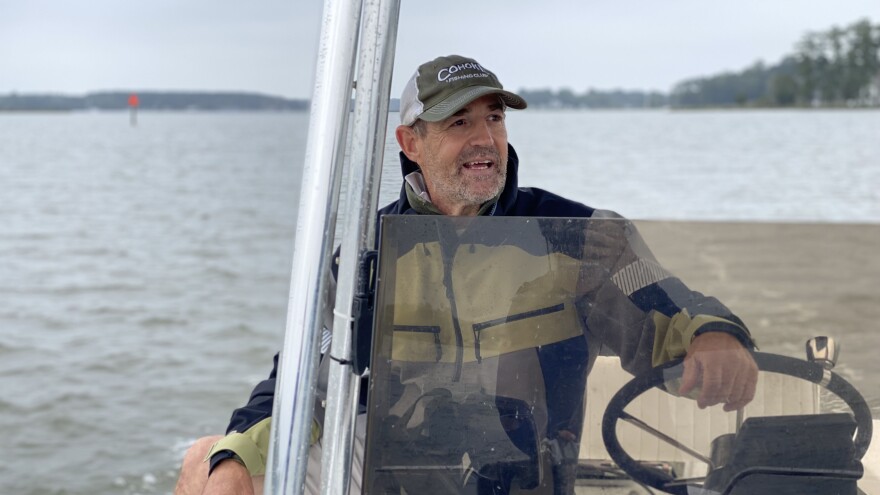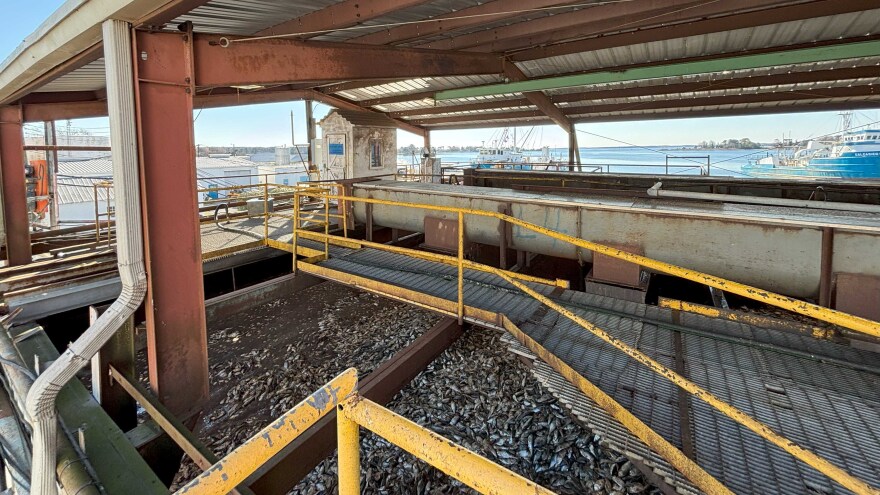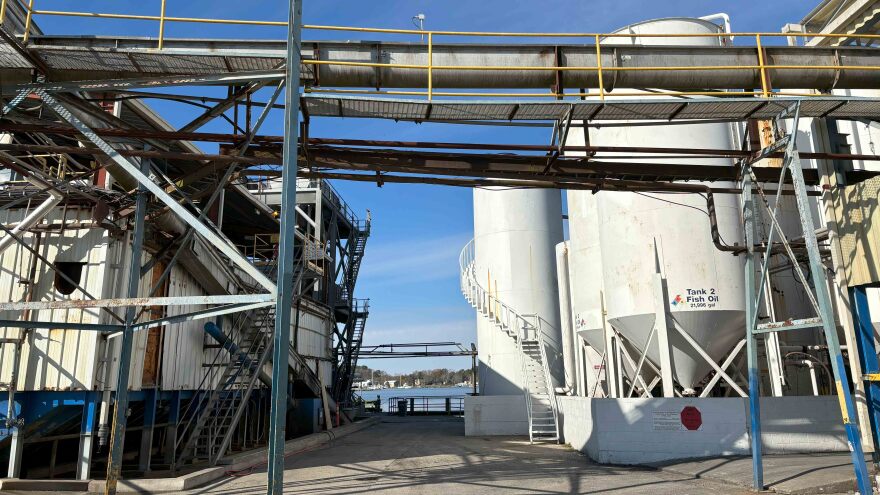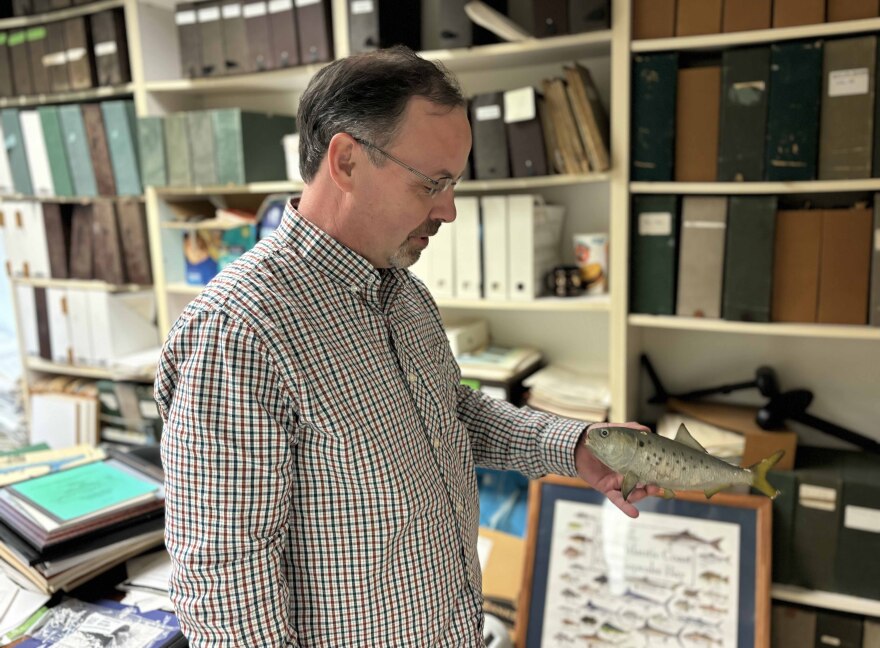Read the original article on WHRO News' website.
On a breezy afternoon, Chris Dollar launched his boat into the Ware River in Gloucester.
Pulling away from the dock, he pointed to small ripples in the water: jumping menhaden, a small, silver fish that's found itself at the center of one of the most heated and longest-running debates in the state.
Dollar has spent his life on the Chesapeake Bay. He owns a charter fishing business, equipping sportfishers and taking them out on the water to catch local favorites like striped bass and rockfish.
Menhaden, he said, are “not a glamorous fish.”
“I wouldn't call them ugly,” Dollar said with a laugh. “But I wouldn't call them poster children for the Chesapeake, writ large.”
But in recent years, menhaden have become a symbol of the Bay. The little forage fish is a crucial part of the local ecosystem, a nutrient-dense food source for species from ospreys and eagles to the striped bass and red drum that support the local recreational fishing industry — and businesses like Dollar’s.
The fish have also been valuable to a commercial fishery dating back more than a century. Each year, hundreds of millions of fish are harvested to produce fishmeal and fish oil for products like pet food and Omega-3 supplements. Virginia is the last East Coast state that allows menhaden reduction fishing.
Now, environmentalists and sportfishing groups throughout the watershed want the state to ban the fishery in the Bay. They worry overfishing is threatening the local menhaden population.
Dollar is one of them. He said he sees drastically fewer fish in the Bay and its tributaries than he used to. Schools of menhaden that used to be “the size of a football field” have shrunk to “maybe a tennis court,” he said. “You see those smaller and smaller numbers.”
He believes the fate of local species that rely on menhaden hinges on getting rid of the commercial fishery.
“You’ve got to wonder if an industrial fishery of this size has a place anymore in the 21st century, in a narrow Chesapeake Bay that's already facing so many other problems,” Dollar said.
But Omega Protein, the last company harvesting menhaden in the Chesapeake, said there’s no evidence backing up the concerns. It's pointed to recent federal surveys indicating that the overall East Coast menhaden population is healthy. Critics argue that data doesn't address what's specifically happening in the Bay.
“It’s not about the science,” Omega spokesperson Ben Landry said about the ongoing criticism. “There’s no amount of factual evidence that can sway a person who, in their heart of hearts, believes menhaden is overfished.”
The company said banning its operations in the Bay would put it out of business, threatening more than 200 local jobs.
Researchers have said more data is needed to fully understand what’s happening in the Chesapeake. But in January, Virginia lawmakers passed on a chance to fund a major study on the status of menhaden. The proposal has been delayed for at least a year.
It’s the latest chapter in a fight that stretches back decades.
“What we need to contemplate as a society is the balance,” said Bryan Watts, director of William & Mary’s Center for Conservation Biology. “How much do we care about the functioning of the ecosystem and the long term health of the ecosystem? And how much do we care about industry?”

A 150-year-old industry faces growing opposition
The 250 million-odd menhaden that Omega Protein catches each year all come to a plant in the small rural community of Reedville.
That’s where Monty Deihl stood on a bright winter morning, along a narrow tributary of the Chesapeake called Cockrell’s Creek.
The commercial menhaden fishery on the East Coast once stretched from Maine to Florida, spreading south from New England after the Civil War. Now, this plant is the last one left.
“We’ve been fishing here since 1878,” said Deihl, CEO of Ocean Harvesters, which operates Omega’s fishing fleet.
From a platform overlooking the water, he pointed down to bins holding the previous day’s catch, packed full of shimmering, silvery blue fish.
“That’s what a million menhaden looks like,” he said.
From these bins, the fish move through the plant, where they are “cooked, squeezed and pressed,” Deihl said, into fish oil and fishmeal used for things like feeding farm-raised salmon and shrimp.
“We use 100% of that fish,” Deihl said.
Now owned by a Canadian seafood company, Omega doesn’t just fish in the Chesapeake Bay. About two-thirds of its harvest comes from the Atlantic Ocean, but it’s all processed in Reedville.

To harvest the fish, Omega uses a method called purse seine fishing. The company sends spotter planes to scout for massive schools of menhaden from the air. The fishing vessels then surround the school with giant nets that cinch on the bottom to prevent fish from escaping.
The scale of the fishery has long led to some clashes with recreational fishermen, but opposition has ramped up in recent years alongside concerns about the scarcity of the fish.
“I can show you a New York Times article from the 1890s talking about sport fishermen and the menhaden fishery battling,” said Landry, the Omega spokesperson. “But, I would say, probably the last four or five years, we've seen a far greater increase in hostility.”
Some local sport fishermen have taken to filming Omega’s operations on the water and posting videos to social media, complaining the industry is wasteful.
Landry said some have even tried to block the fishing vessels with their boats or jet skis.
The fishery used to be controlled directly by state lawmakers, making regulatory decisions highly political. Since 2020, it’s been in the hands of the Virginia Marine Resources Commission, a state agency with commissioners appointed by the governor.
Some of the increased attention came after a series of industrial net tears in the summers of 2021 and 2022 spilled tens of thousands of dead menhaden onto Virginia beaches, appalling residents and tourists with the sight and smell.
“That created a great deal of public concern,” said Rob Latour, a professor at William & Mary’s Virginia Institute of Marine Science, which researches menhaden for state regulators.
Pressure mounted on Gov. Glenn Youngkin’s office, with opponents calling for a moratorium on menhaden fishing in the Bay. VMRC staff instead proposed some lower-level restrictions, pushing Omega’s operations further from shore.
The deciding commission meeting in late 2022 was standing room only, with marine police officers there to keep the peace. Public comments stretched nearly four hours and included impassioned pleas from both sides.
Commissioners ultimately opted not to codify any new restrictions, instead reaching a deal with Omega to harvest less on days when there’s more beachfront activity, like holiday weekends during the summer.
“It still resonates as a sore spot in the minds of many,” Latour said.
Omega argued the industry is already tightly regulated, and points to recent assessments by the Atlantic States Marine Fisheries Commission, which regulates the fishery coastwide, that found the full Atlantic menhaden population is not overfished.
Critics are ignoring that data, Diehl said.
“They're not being objective about the fishery,” he said. “They don't understand the fishery and they're not listening to the science.”

'The things you need to know, we don’t know'
The science itself is now at the heart of the debate.
The menhaden population crashed during the 20th century, but has bounced back significantly after new catch limits were imposed in recent decades — including on Omega, whose annual menhaden take is currently capped at about 250 million fish.
“Quite frankly, if this were any other species, I think we'd all be celebrating,” said Latour, the marine scientist.
A few years ago, the Atlantic marine fisheries commission also started incorporating ecosystem impacts in its regulatory decisions, a win for environmentalists. But critics have said the commission's numbers, which track the Atlantic menhaden population along the entire East Coast, could obscure a more localized decline in the Chesapeake Bay.
Latour said that’s possible. But scientists don’t yet have the data to say either way.
“I don't fault people for thinking about that,” he said. “But it's a very complicated thing to actually determine with sufficient evidence scientifically. The things you need to know, we don't know.”
Collecting data on the Bay menhaden population would be expensive, including likely using the same spotter planes Omega does to conduct fish surveys. Latour said scientists also don’t know that much about the fish’s life cycle, which spans the coast, making it further difficult to study just the Bay.

Advocates hoped Virginia lawmakers would fund that research at this year’s legislative session.
Latour’s team worked with people on all sides of the issue — fishermen and environmental groups, along with Omega — to develop a plan for a nearly $3-million study on the menhaden population in the Bay, as well as impacts of the commercial fishery and menhaden policy.
But in January, lawmakers tabled a bill to fund the study. It won’t be considered again until at least next year.
Advocates said Omega actively lobbied against the bill. The company has denied those claims.
Environmental groups expressed outrage with the Chesapeake Bay Foundation, calling the efforts over the last year “wasted.”
“It was a disappointment because there were so many people who had a stake in this who had been involved in the discussions over the course of a year,” said Virginia Del. Lee Ware, a Republican who proposed the bill. “And that was a keen disappointment because it's so important to the health and to the economy of the Chesapeake Bay, which itself is such a gem, in Virginia's natural environment.”
Landry, the Omega spokesperson, said the company aims to continue "future conversations about how to proceed with management that uses sound science."
Other local researchers have tried to fill in the data gap. Watts, the bird researcher at William & Mary, has recently published studies linking declines in the local osprey population to a scarcity of menhaden as food.
Even without the new study, a coalition of sportfishers and conservation groups continues to push for a menhaden moratorium in the Bay, with a lawsuit currently moving through the courts, and an active petition filed with state regulators. (It garnered more than 1,000 public comments.)
Dollar, the fishing captain, said there’s an old saying about fishery politics: It’s a marathon, not a sprint.
“'Well, I've amended that,” he said. “When it comes to menhaden, particularly in Virginia, it's an ultramarathon, not just a marathon.”


